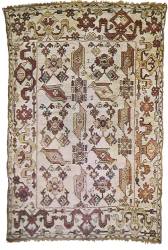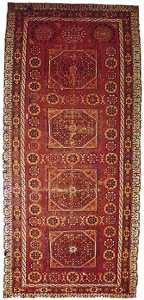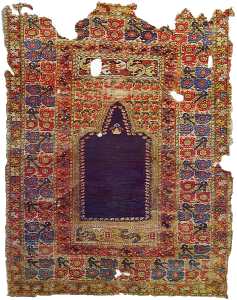The Art of Turkish Carpet Weaving
 Carpets
discovered in excavations of tombs at Pazarık have proved that the ancient Turks wove
carpets using the complex Gördes knot technique as early as the Hun period. However,
researchers then encounter an unexplained gap until the fragments of 3rd and 6th century
carpets made using a simple weft knot discovered at the turn of this century at Lou-Lan
west of Lake Lop in Eastern Turkistan. Possibly the sophisticated technique of the
Pazarık carpet had been forgotten over the intervening centuries, and the process of
evolution began all over again with the discovery of a simple knot. When we come to
Islamic times, we find among the Abbasid carpet fragments with geometric designs some
found at Fostat (old Cairo)whose knotting technique resembles that of Eastern Turkistan. Carpets
discovered in excavations of tombs at Pazarık have proved that the ancient Turks wove
carpets using the complex Gördes knot technique as early as the Hun period. However,
researchers then encounter an unexplained gap until the fragments of 3rd and 6th century
carpets made using a simple weft knot discovered at the turn of this century at Lou-Lan
west of Lake Lop in Eastern Turkistan. Possibly the sophisticated technique of the
Pazarık carpet had been forgotten over the intervening centuries, and the process of
evolution began all over again with the discovery of a simple knot. When we come to
Islamic times, we find among the Abbasid carpet fragments with geometric designs some
found at Fostat (old Cairo)whose knotting technique resembles that of Eastern Turkistan.
A wool carpet fragment bearing a palmette motif on a red ground and worked in Gördes
knots (named after the Turkish carpet weaving centre of Gördes and alternatively known as
the Turkish knot), found at Fostat and now in Cairo's Museum of Islamic Art marks the
beginning of knotted carpet making in the mediaeval Islamic world. It is thought that this
carpet must have been exported from Western Turkistan between the 7th and 9th centuries.
Another fragment in Berlin Museum of Islamic Art may have been imported from Western
Turkistan, perhaps Bukhara to Egypt. Since there are no other contemporary fragments from
that region for comparison, we can not say more.
 The
other carpet fragments discovered in Egypt are made in the single warp knot technique of
Eastern Turkistan, and the dominant ground color is dark blue. These fragments are now in
the Benaki Museum in Athens. The
other carpet fragments discovered in Egypt are made in the single warp knot technique of
Eastern Turkistan, and the dominant ground color is dark blue. These fragments are now in
the Benaki Museum in Athens.
Anatolian Turkish carpets dating from the 13th century found in Konya are woven in the
Gördes knot. These carpets are the earliest for which provenance and dating involve no
speculation. The discovery of eight Turkish Seljuk carpets by F. R Martin in Alaeddin
Mosque in Konya in 1905, was followed by three more Seljuk carpets found by R. M.
Riefstahl in 1930, and seven small carpet fragments found in Fostat in 1935-1936.
The art of carpet weaving was introduced to the Islamic world by Turkish tribes
migrating from Central Asia, and the single-warp knot spread as far as Spain. Carpets from
Turkey were highly valued in Europe where they became a popular accessory in paintings.
The introduction of animal figures into 14th century Turkish carpets parallels the
vigorous use of animal designs in many other branches of Seljuk art. These carpets were
already being exported to Europe, as pictures of Seljuk period Turkish carpets in European
paintings of this period indicate. Original examples of these carpets bearing animal
figures were not discovered until centuries later, however, in Konya, Istanbul and Fostat.
 Following
the three Seljuk carpets which R. M. Riefstahl found in Beyşehir, he found a fourth large
15th century carpet which was the prototype of the so-called Holbein carpets, representing
another phase in the development of Turkish carpets. Following
the three Seljuk carpets which R. M. Riefstahl found in Beyşehir, he found a fourth large
15th century carpet which was the prototype of the so-called Holbein carpets, representing
another phase in the development of Turkish carpets.
These carpets were represented in paintings by Italian and later Flemish and Dutch
artists between the mid 15th and 16th centuries, but became known as Holbein
carpets because they appeared most frequently and in greatest detail in paintings by this
artist. They feature borders with an interlaced design inspired by the kufic Arabic
script, and a field of geometric designs enhanced by highly stylized floriate motifs. They
mark the beginning of a new Ottoman Turkish style of carpet design. The 16th century saw
the rise of a new and brilliant period in Turkish carpet weaving corresponding to the
classical period in Ottoman architecture and other arts. Carpets made in the Uşak region
mark the commencement of this development with an extraordinary diversity of motif and
composition which still await detailed study. Uşak carpets can be divided into two main
types, those with medallions and those with a design of stars but variations on these two
themes employ an immense repertoire of motifs. The medallion carpets were often conceived
as an infinite repeating pattern by placing halved medallions in the four corners around
the central medallion.
The medallion itself is a motif inspired by book binding and illumination of the
practiced by the carpet weavers of Tabriz, but now combined with the idea of infinite
repetition typical of Turkish carpets. Instead of retaining the principles of composition
applicable to the arts of the book, Turkish designers were guided entirely by the rules
and characteristics of the textile medium in which the weavers worked.
Star Uşak carpets display the principle of infinite repetition even more prominently,
this effect being achieved by arranging small medallions in the form of eight pointed
stars and diamonds in offset rows.
This type is smaller in size than the medallion carpet. Production of star Uşaks
continued for only two centuries, disappearing by the end of the 17th century, while the
medallion Uşak carpets continued to be woven until the mid-18th century.
In the late 16th century, an entirely different type of Turkish carpet, new both in
technique and its predominantly naturalistic motifs, emerged alongside the classic Turkish
carpet. Known as the Ottoman court carpet, it employed the Persian rather than Turkish
knot. The Persian knot, also called the asymmetrical knot, allows a finer, velvet like
texture to be created. Naturalistic motifs appear simultaneously in all other Turkish arts
at this time, with a profusion of tulips, hyacinths, roses, blossom, and curved leaves.
This style continued to evolve until the end of 18th century.
 Ottoman
court prayer rugs were made in the Gördes, Kula, Ladik and Uşak tradition during the
18th century. A magnificent prayer rug known to have belonged to Ahmet I
(1603-1617) in Topkapı Palace Museum is still clearly worthy of a sultan, despite the
burns caused by a brazier being placed on top of it. Another court prayer rug in Berlin
Museum has a chronogram in the border giving the date 1019 (1610). Ottoman
court prayer rugs were made in the Gördes, Kula, Ladik and Uşak tradition during the
18th century. A magnificent prayer rug known to have belonged to Ahmet I
(1603-1617) in Topkapı Palace Museum is still clearly worthy of a sultan, despite the
burns caused by a brazier being placed on top of it. Another court prayer rug in Berlin
Museum has a chronogram in the border giving the date 1019 (1610).
The oldest known prayer rugs to have survived date from the 15th century, and
constitute a distinct category of Turkish carpets. Three of these in the Museum of Turkish
and Islamic Art in Istanbul feature completely different compositions, which indicates
that this was a period when innovation and creativity were given free rein. Other 15th
century prayer rugs can bee seen in Renaissance period paintings by the Bellinis,
Corpaccio and Lotto. Giovanni Bellini's portrait of Duke Loredan of Venice dated 1507 in
the Munich Gallery shows a prayer rug identical to one in the Berlin Museum of Islamic
Art. Another early example can be seen in a painting by Gentile Bellini hanging in the
National Gallery in London.
 The
serrated lappet on the Bellini prayer rugs is replaced by a large palmette on the lower
edge of a magnificent early 16th century Uşak carpet in Berlin Museum. Another Uşak
carpet dated 1600 in the Bode collection is among the first examples of the double mihrap
niche rugs with a central medallion and an unusually broad border. Unfortunately very few
prayer rugs dating from the 15th and 16th centuries have survived, but the number and
variety rises sharply for the 17th century, when we find Gördes prayer rugs with curved
niches closely style rugs. Kula prayer rugs are distinguished by plainer niches and up to
ten narrow borders. There is also a type known as landscape Kula, with designs of
cottages and trees. The
serrated lappet on the Bellini prayer rugs is replaced by a large palmette on the lower
edge of a magnificent early 16th century Uşak carpet in Berlin Museum. Another Uşak
carpet dated 1600 in the Bode collection is among the first examples of the double mihrap
niche rugs with a central medallion and an unusually broad border. Unfortunately very few
prayer rugs dating from the 15th and 16th centuries have survived, but the number and
variety rises sharply for the 17th century, when we find Gördes prayer rugs with curved
niches closely style rugs. Kula prayer rugs are distinguished by plainer niches and up to
ten narrow borders. There is also a type known as landscape Kula, with designs of
cottages and trees.
Ladik prayer rugs are noted for their soft wool and glowing colors and are
characterized by rows of long stemmed tulips below or above the prayer niche. Those of Kırşehir and Mucur have niches with double or triple
outlines and their color schemes include two or three tones of red. With their vivid and
brilliant colors, Milas prayer rugs preserve the forms of Gördes prayer rugs with the
additional influences of Uşak and Bergama rugs.
Turkish carpet weaving continued to develop through to the end of nineteenth century,
and still survives today in Konya, Kayseri,
Sivas, Kırşehir, Isparta, Fethiye, Döşemealtı, Balıkesir, Yağcıbedir, Uşak, Bergama, Kula, Gördes, Milas, Çanakkale, Ezine, Kars and Erzurum. Enormous efforts
being made to prevent the art of carpet weaving falling into decline are meeting with
considerable success in many areas of Turkey today. |